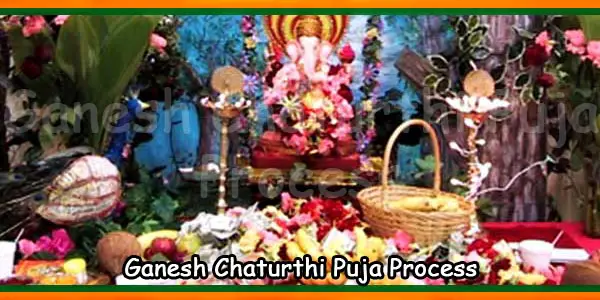Ganesh Chaturthi Pooja Vidhi signifies the worship of Lord Ganesh, the elephant-headed deity, in the month of Bhadrapada, following a sixteen step ritual known as Shodashopachara in compliance with Hindu scriptures. Even though Madhyahnakala (afternoon) is the best time to perform Ganesh puja, it can also be done during Pratahkala (morning) or Sayankala (evening). Whatever be the timing, the worship of the Lord should be done sincerely in accordance with the Ganesh Chaturthi Pooja Vidhi.
Important Stages of Ganesh Chaturthi Pooja Vidhi:
1) A pedestal is prepared at the place of worship and the pedestal is covered with a red cloth.
2) A clay idol or a picture of Lord Ganesh is placed on the pedestal. Then Pranopchar and Shodashopachara, are done, which are very important processes of Ganesh Chaturthi Pooja Vidhi.

3) Pranopchar: Pranopchar literally means “invoking life into the clay idol”.
a) The puja begins with the lighting of earthen lamp and incense sticks.
b) Prayers are offered to the Lord to invoke his blessings.
c) Holy water is sprinkled on the idol.
d) The idol is then offered a sacred thread to represent the offering of clothes to the deity.
e) Tilak of Roli or sindoor is applied to the deity’s forehead.
f) Modak, laddoo, flower garlands and holy water from the River Ganges are offered to the deity.
4) Shodashopachara
a) Avahana: Avahana literally means “to welcome and invoke the blessings of gods and goddesses”. The Avahana Mudra is observed by joining the palms of our hands, and mantra is chanted.
b) Pratishthapan: The clay idol is installed while chanting mantra.
c) Asana Samarpan: After the rituals of establishing and invoking the Lord, prayers and flowers are offered, amidst chanting of mantras. It is called Anjali.
d) Padya Samarpan: Water is offered to Lord Ganesh to wash his feet, chanting mantras all along.
e) Arghya Samarpan: Perfume is offered to Lord Ganesha while sacred mantras are chanted.
f) Achamana: This is another ritual of offering water to the Lord.
g) Snana Mantra: This is offering water to the Lord for bathing.
h) Panchamrita Snanam: The “five elixirs” offered to the Lord for his bath, which include Honey, sugar, milk, curd, and ghee.
i) Dugdha, Dadhi, Ghrita, Madhu, Sharkara, Suvasita and Shuddhodaka Snanam: This is bathing the Lord with milk curd, ghee, honey, sugar and perfumed oil or holy water in order.
j) Vastra Samarpan: Offering new cloth to the lord.
k) Pushpa Mala, Shami Patra, Durvankura, Sindoor, Dhoop, Gandha and Akshata Samarpan: Offering flower garland, leaves, grass, vermilion, incense sticks, perfume and unbroken rice to the Lord.
l) Tambula, Narikela and Dakshina Samarpan: Offering Betel nut, coconut and gifts.
m) Neerajan and Visarjan: The worship is concluded with Visarjan, which means drowning the idol in water.
The Ganesh Chaturthi Pooja Vidhi specified above is strictly observed all over India while celebrating the festival of Ganesh Chaturthi.

